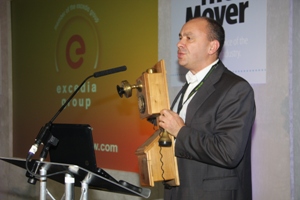The December issue of The Mover reported on the Mover Conference at Silverstone. There was far too much going on at the conference to include in one issue of the magazine so, to complete the picture, here’s part two that looks at the media and how to use it, and includes an interview with Rennie Schafer, from the Self Storage Association.

Making the most of Media
The second day of The Mover Conference began with a three part session about using various types of media, both traditional and high-tech, to maximise exposure, win new customers and ultimately improve your bottom line.
Solving the PR mystery
Things kicked off with a presentation by The Mover editor Steve Jordan, about PR and how to use the press to gain free publicity. Steve began by stating what sounds like the blindingly obvious, “If the press don’t know about your news they won’t print it, so you need to let them know what’s happening.” Steve also talked about the importance of taking a good picture to go with the story and that often a picture can mean the difference between a story being ‘picked-up’ or ending up in the bin. “Often we get stories at The Mover from companies that have moved someone famous and not taken a picture – that probably means we won’t use the story.”
Delegates were encouraged to make contact with their local press, radio and TV and keep in touch through regular press releases about things that may be of interest to the local population. This will not only get stories published but mean they contact you when they need an expert to comment on matters involving the moving industry.
Steve ended by saying, “If you don’t think PR is important just think how a bad news story would affect your business.”
Steve Jordan: 01908 695500 www.themover.co.uk
 Using social media
Using social media
Continuing with the publicity theme, Jon Baker from The Excedia Group took to the stage to talk about using social media to engage and maintain contact with customers and prospects. Jon’s talk focused on Facebook and he began by giving the staggering statistic that during his 15-minute presentation 7.5 million messages would be posted via the Facebook network.
Having lugged onto the stage a huge ancient telephone Jon explained that back when it was made many people saw the phone as a nuisance, something that would interrupt their work and waste valuable time and that some business people still view social media in the same way.
There are now over 24,000,000 registered users on Facebook in the UK and contrary to what a lot of people think they’re not all kids; 62% of people between the age of 35 and 50 regularly use social media and 20% of 65 to 75 year olds do too. “People are becoming increasingly resistant to conventional advertising,” said Jon. “How many of you have Sky+ and fast forward through the adverts? No one uses Yellow Pages anymore to look for a supplier, they look on the Internet and using social media will make you easier to find and help you get the business.”
Jon went on to say how important it is to have a good profile on LinkedIn and the relatively new Google Plus as again they help to optimise search engine visibility and drive customers to your site. Most people agree that recommendation is the best way of winning business and again social media is an excellent way of obtaining recommendations and getting them in front of potential customers.
“Like it or not guys this stuff is here to stay,” said Jon. “We can complain about it as much as we like but we should see it as an opportunity however much we may hate it.”
Jon Baker: 01234 750939 www.venture-Now.com
 Making the web work for you
Making the web work for you
The final part of the media session was hosted by Iain Row from web developer Prominent Media who introduced a number of ideas on how the web could be used more effectively in a removals business. Iain talked about how in the Internet age people want to complete tasks in a single session, perhaps in the evening or at the weekend and so a site that enables them to do that without having to wait for a call back from the supplier is likely to be the most successful.
An online quote system for example is often used by the bigger companies, but few of the smaller movers have one. With modern software this is now something everyone can offer without spending a fortune. “It’s important to create a ‘stop point’, that is a point at which the customer feels they have achieved their objective and don’t need to visit another company’s site,” said Iain. “Giving the customer an online quote for a move, albeit with some caveats, will make it much less likely they’ll look elsewhere.”
If customers do need to arrange a visit an online appointment facility can also be built into the website so they can book a firm appointment there and then, without the need to wait for a call from the company to arrange a suitable time. Iain went on to give a number of examples of the systems available, including one which is available free for companies making fewer than 50 bookings a month.
Iain continued, “Apart from being more convenient for both you and the customer, using the Internet in this way send out a message that you are a modern company with the latest technology and systems and that this will be reflected in the way you operate as a company.”
There was something from Iain for the bigger companies too. His company had developed an online system that allows customers to track the chain of their move and thereby keep better control of the whole process. By sponsoring the site, a moving company could gain access to all this information including the dates of every move in the chain.
Iain closed the presentation by showing how opening an online shop for packaging and other moving materials can bring an additional revenue stream and also help engage with people about to move house.
The session ended with several very positive comments from delegates about the value of the presentations and the expertise of the speakers taking part.
Iain Row: 01908 239971 www.prominentmedia.com
Photos: Steve Jordan; Jon Baker with his ancient telephone and Iain Row of Prominent Media.
 Becky Adams provides customer service advice
Becky Adams provides customer service advice
At The Mover Conference in October, Mark Ratcliffe from The Small Moving Company won a free day’s training from keynote speaker Becky Adams. During her visit to sunny Eastbourne, Becky helped Mark and his team to plot the customer journey. “We worked together to pin point where his sub-conscious customer journey and sales process may cause potential clients to change their minds about doing business with him and go elsewhere,” said Becky. “At which stages of the process they 'drop out' because of things he may unknowingly do or say or how the business is sub-consciously viewed by potential customers. We identified several things on his website which if changed would bring him more business, and I was able to show him why he was only attracting certain types of customer and how he could appeal to those who would spend more for minimal expenditure. It was an intense day, with Reese his porter giving very useful insight into customer feedback.”
 Mark was delighted and grateful for the help Becky provided. “It was the most productive day we've had at The Small Moving Company for a long time,” he said. “We've been missing so many opportunities.” He added that Becky had: “opened up a whole new world to us and helped us to take a serious look at our business procedures. Changes will be made at next to no extra cost to make our organisation more profitable and customer friendly.”
Mark was delighted and grateful for the help Becky provided. “It was the most productive day we've had at The Small Moving Company for a long time,” he said. “We've been missing so many opportunities.” He added that Becky had: “opened up a whole new world to us and helped us to take a serious look at our business procedures. Changes will be made at next to no extra cost to make our organisation more profitable and customer friendly.”
For more information on Becky’s business advice services contact her at: madambecky@live.co.uk
Photos: Becky helps mark get to grips with his customer journey
Rennie Schafer Speaks at The Mover Conference
 One of the most eagerly anticipated speakers at the The Mover Conference was the Self Storage Association UK’s brand new CEO Rennie Schafer.
One of the most eagerly anticipated speakers at the The Mover Conference was the Self Storage Association UK’s brand new CEO Rennie Schafer.
Rennie began by giving some statistics showing the types of customers currently using self storage and how peoples’ awareness of the service has changed during the past few years. Apparently 57% of private customers are female and 40% of capacity is used by business – much higher than in other countries such as the US, Australia and New Zealand.
Perhaps surprisingly, only 12% of business comes from house moves, which explains why the self storage business has remained relatively strong during the past five years when fewer people have been moving house. “Most customers, 90%, are local,” said Rennie. “The average travelling time is only ten minutes so marketing needs to be aimed at the local population. Often people will pay more for a local unit rather than travel to a cheaper one.”
Rennie went on to say that peoples’ awareness of self storage is increasing with around 60% of the public in London and 40% outside the capital now having a good understanding of the services available. This compares with an overall figure of around 25% only six years ago. The need for high-profile sites is also less important as awareness and the use of the internet increases. Currently 51% of bookings are made via the internet creating opportunities for smaller operators to enter the industry using sites in secondary positions.
Customers are also becoming aware of the different types of storage units available. Not everyone needs the very highest levels of security for example and this is opening up a budget segment in the market in the same way as the hotel market has developed during the past 15 years.
Occupancy rates are currently running at around 70% with lower figures for immature sites. For a new 250 unit site it normally takes two summers (the busiest time) to reach maturity with the first 50% being the easiest to achieve. The average return on net letable space in the UK is £13.57 per sq ft. per annum, £19.26 in London.
Rennie ended his presentation by highlighting some of the things removals companies tend to do badly when they enter the self storage business. Some newcomers rely too much on their removals customers, which is a mistake because they only represent about 12% of the overall market. He also emphasised the need to be retail focussed and make it easy for customers to access the site, this is often not the case with a removals company. It is also important to market the company as a self storage facility and not as an add-on to the removals business.
After the presentation Rennie took part in a lively discussion about the pros and cons of the self storage business. It is clearly a subject of great interest to people in the moving industry.
rschafer@ssauk.com 01270 623150 www.ssauk.com
Photo: Rennie Schafer
Click here to see the next Editor's pick